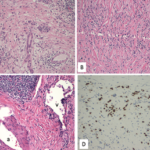 ACR Convergence 2021—On Nov. 7, attendees of the Rheumatology Secrets & Pearls session gained new insights into the diagnosis, management and treatment of an array of rheumatic diseases, from bread-and-butter conditions to rare clinical entities.
ACR Convergence 2021—On Nov. 7, attendees of the Rheumatology Secrets & Pearls session gained new insights into the diagnosis, management and treatment of an array of rheumatic diseases, from bread-and-butter conditions to rare clinical entities.
Jason Kolfenbach, MD, associate professor of medicine and ophthalmology and director of the Rheumatology Fellowship Program at the University of Colorado, Denver, led the popular session, along with John H. Stone, MD, MPH, professor of medicine at Harvard Medical School, and director of clinical rheumatology at Massachusetts General Hospital, Boston.
Dr. Kolfenbach explained that clinical pearls can be useful when randomized controlled trial data are not available for a particular question or when the data are available but don’t address a particular patient’s clinical scenario. Here are 10 pearls from their presentation.
Vasculitis Pearls
1. Dr. Stone discussed a unique manifestation of anti-neutrophil cytoplasmic antibody (ANCA) associated vasculitis: strawberry gingivitis.1 “Strawberry-like gingivitis is a clue to the diagnosis of granulomatosis with polyangiitis [GPA],” he explained. These lesions are not always florid throughout the mouth, and they may be subtle. However, if present, they are “strongly suggestive” of GPA.
2. When evaluating a patient for a potential diagnosis of vasculitis, it is important to recognize that ANCA-associated vasculitis does not typically cause hard palate lesions, Dr. Kolfenbachexplained. ”Hard palate lesions should bring to mind malignancy or cocaine-induced destructive lesions,” he said.
A human neutrophil elastase (HNE) antibody test can be useful in this setting. This antibody is sometimes present in cocaine-induced midline lesions but not in ANCA-associated vasculitis. However, the assay is not available commercially.
3. Next, Dr. Stone discussed some pearls and myths related to Takayasu’s arteritis. He noted that immunosuppression is often not urgently needed in the treatment of Takayasu’s arteritis. This is, in part, due to the collateral circulation that often develops; patients with such collaterals are not at risk for limb-threatening ischemia.
“Stenting should be undertaken after careful thought and reconsideration because of exuberant collateral circulation that develops, making stenting irrelevant in most cases,” he explained.
One final pearl: Dr. Stone said to remember to listen for bruits on the patient’s back on both sides of the spine. “If you detect a bruit, it may have one of two origins: the pulmonary artery or the descending aorta,” he said.
Sarcoid Loves the Nasal Ala
4. Dr. Kolfenbach presented the case of a patient with atrophic skin changes over the cheeks that could be mistaken for discoid lupus. However, this patient had granulomatous changes due to lupus pernio (also called Besnier-Tenneson syndrome), a form of cutaneous sarcoidosis. Lupus pernio tends to present with violet-colored papules or plaques on the nose and cheeks, whereas discoid lupus tends to present with indurated plaques on the head and neck.




